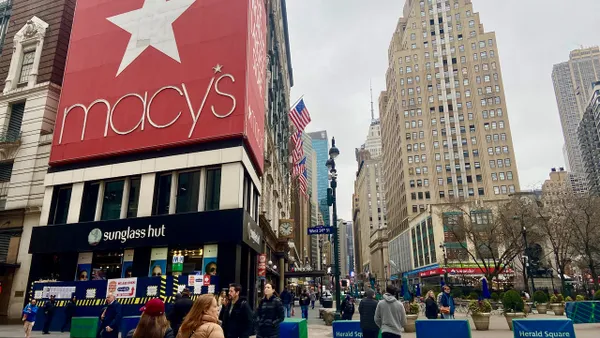Dive Brief:
-
J.C. Penney on Friday reported that Q2 total revenues plummeted 9.2% year over year to $1.5 billion, as total net sales fell 8.9% to $1.5 billion and credit income fell 16.9% to $59 million. Traffic remained soft in the period.
-
The department store added more than 830,000 new rewards members and 30,000 credit customers in the period, following the revamp of its loyalty program earlier this year. Store net promoter scores improved more than four points year over year.
-
The department store swung into the red, from a net income of $36 million a year ago to a $33 million net loss. Consolidated adjusted EBITDA plunged 80% to $29 million, per financial filings.
Dive Insight:
J.C. Penney has put lower-income households at the center of its marketing campaign, noting in its report last week that in Q2 it “remained focused on serving American’s hard-working families with a heightened sense of urgency given the overall economic difficulties they face in today’s environment” and that it “continues to provide affordable fashion and merchandise that allows customers to make fashionable choices without sacrificing quality.”
That comes with a price.
“This is a very soft set of results from JCPenney, which shows the group is still being buffeted by the chill winds of a more constrained consumer and some of its own internal challenges,” GlobalData Managing Director Neil Saunders said by email. “Given JCP is exposed to more financially sensitive shoppers it is perhaps not surprising that the numbers are weak. Even so, it is disappointing that the decline is worse than the prior quarter.”
J.C. Penney and rivals Kohl’s and Macy’s are all in the midst of turnarounds amid stiff competition from lower-cost alternatives, including off-price retailers and mass merchants like Walmart, Target and Amazon. In their own second quarters, Kohl’s net sales fell 4.2% and Macy’s fell 3.8%.
“An 8.9% dip in retail sales puts JCPenney at the bottom of the league table compared to its department store peers — something that underlines the fact there is a lot more work to do in rebuilding the proposition to make it more compelling,” Saunders said. “Some of this work is underway, but it is clearly not yet fully delivering.”
One advantage that J.C. Penney has over its peers is its private ownership. While Macy’s is busy closing dozens of stores over the next few years, for example, Penney has plans to close just three this year and one next year. The fact that its two major owners are also its two major landlords, Simon Property Group and Brookfield Properties, is another likely advantage. The mall owners have major incentives to keep as many anchor spaces filled as possible; earlier this year David Simon, CEO of Simon Property Group, told analysts that J.C. Penney could eventually even open more locations.
J.C. Penney on Friday noted progress in trimming costs, saying that a slight increase in selling, general and administrative costs was largely due to the timing of its marketing spend compared to last year. In Q2, the company also generated $47 million in cash, including “improvements in working capital offset by seasonal purchases of inventory” and had capital expenditures of $59 million for projects aimed at driving long-term growth, per its filing.
But the company isn’t making money, with even “some erosion” in EBITDA, Saunders warned. The company’s turnaround “success stories ... are outweighed by the challenges elsewhere in the business,” and it “desperately needs some wins on the board to provide confidence that it is headed in the right direction,” he said.
“There is clearly some cost saving going on, but this is being outpaced by the sales declines which puts the bottom line under pressure,” he also said. “JCP has time because of its ownership structure, but it is important for it to move into financial stability and demonstrate it can deliver a return.”















